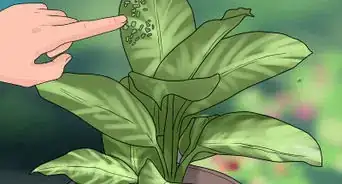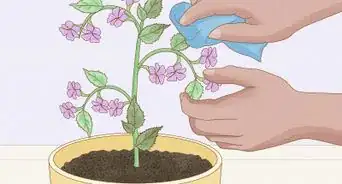This article was co-authored by Chai Saechao. Chai Saechao is the Founder and Owner of Plant Therapy, an indoor-plant store founded in 2018 based in San Francisco, California. As a self-described plant doctor, he believes in the therapeutic power of plants, hoping to keep sharing his love of plants with anyone willing to listen and learn.
wikiHow marks an article as reader-approved once it receives enough positive feedback. In this case, 97% of readers who voted found the article helpful, earning it our reader-approved status.
This article has been viewed 260,650 times.
Houseplants can add color and fresh air to a room. To keep your houseplants looking their best, you should prune them regularly with sharp scissors or gardening shears. Start by removing dead leaves, limbs, and flowers on the plants. Then, cut back overgrown branches and stems on the plants. You should also maintain the plants by fertilizing them and watering them regularly so they stay healthy and happy.
Steps
Removing Dead Leaves, Limbs, and Flowers
-
1Use sharp scissors or garden shears. Make sure the scissors or garden shears are very sharp, as dull shears can damage the plants. If you notice any dirt on the shears, soak them in water with a teaspoon of bleach and then wipe them dry. A clean tool will ensure your plants are not exposed to bacteria or pests when you prune them.[1]
- You can find garden shears for pruning online or at your local hardware store.
- If you are worried about scratching your hands while you prune, wear gardening gloves.
-
2Prune the plants at the beginning of their growing season. If you have houseplants that do not flower, prune them in late winter. For houseplants with flowers or blooms, wait until they have bloomed before you prune them.[2]
- Do not prune houseplants when unopened buds are present on the stems.
Advertisement -
3Remove dead leaves and limbs at a 45 degree angle. Look for any leaves or limbs on the plant that are brown or discolored. They may also appear limp or dry. Use the shears to cut them off just below the brown or dead area at a 45 degree angle. This will ensure you leave as much of the healthy foliage on the plant as possible.[3]
- Do not cut off any leaves or limbs that still appear green and vibrant.
- If a large section of the leafy area appears dead, you can cut off the entire branch. Leave the main stem intact and remove branches shooting off of the stem at a 45 degree angle.
-
4Trim off any dead flowers. If you have houseplants that are flowering, make sure you check them over for any dead flowers and remove them. The flowers may appear brown, discolored, and limp. They may also feel dry to the touch. Cut the dead flowers off with the shears at the base of the flower’s head.[4]
- Removing dead and dying flowers on the plant will encourage the growth of newer, more vibrant blooms.
Cutting Back Overgrown Branches and Stems
-
1Prune back half of the longest branches on the plant. Use the shears to cut them back about a third of their length. Trim the branches off at a 45 degree angle.[5]
- If there are any side shoots on the branches further down the base of the plant, you can prune a few of these shoots.
- Do not cut off any nodules on the plants as you prune, which are new buds that have not bloomed or opened yet.
-
2Remove leggy stems. Check the plant for any stems that are unusually long. They may appear loose or straggling, falling off different areas of the plant. Pruning leggy stems will help the plant to grow in a fuller, more even pattern. Use the shears to cut the leggy stems back to one third their length, cutting at a 45 degree angle.[6]
-
3Pinch off the stems. If you have soft-stemmed houseplants like coleus, heartleaf philodendron, and English ivy, make sure you pinch them regularly. Use your thumb and forefinger to remove the tip of a stem. Pinch above the node, which is the growing point where the leaf is attached to the plant.[7]
- Pinching off the stems can help maintain the bushy shape of the plant and encourage even growth. It also helps to prevent the growth of leggy stems.
-
4Remove 10-20% of the plant’s foliage at a time. Do not over prune the plant, as this can make it difficult for it to grow properly. Make selective cuts to the plant, removing only 10-20% of the foliage at a time. Wait a few weeks to one month to prune the plants again.[8]
- Always leave some foliage on the plant when you prune. If you are in doubt, under prune the plant and then reevaluate it a few weeks later.
Maintaining Houseplants
-
1Fertilize the plants after pruning. Use soluble, all-purpose fertilizer on the plant after you prune it. Dilute the fertilizer in water so it does not burn the plant. Apply the fertilizer according to the instructions on the label.[9]
-
2Wipe dust or dirt off the leaves. Houseplants with wide, large leaves can accumulate dust and dirt. Maintain the houseplants by using a damp sponge or rag to wipe off the dust and dirt. Do this on a regular basis so the plants stay vibrant.[10]
- Always use a new sponge or rag on each plant so pests are not transferred from one plant to another.
-
3Do not overwater the plants. A big part of caring for houseplants is watering them when needed. Thin, delicate houseplants will need more water than hearty succulents.[11] Check if the plants need water by sticking your finger one inch into the soil. If the soil does not feel damp, the plants need water.[12]
- Watch for signs of overwatering, such as young and old leaves that fall, mushy, brown roots at the bottom of the pot, moldy flowers, and leaves with brown, soft patches that do not grow.
Expert Q&A
-
QuestionShould you prune roots if they start sticking out of the soil?
 Chai SaechaoChai Saechao is the Founder and Owner of Plant Therapy, an indoor-plant store founded in 2018 based in San Francisco, California. As a self-described plant doctor, he believes in the therapeutic power of plants, hoping to keep sharing his love of plants with anyone willing to listen and learn.
Chai SaechaoChai Saechao is the Founder and Owner of Plant Therapy, an indoor-plant store founded in 2018 based in San Francisco, California. As a self-described plant doctor, he believes in the therapeutic power of plants, hoping to keep sharing his love of plants with anyone willing to listen and learn.
Plant Specialist No, you really don't want to go that route. The roots are an especially delicate part of the plant and you may accidentally kill the plant if you cut them the wrong way. If the roots are sticking out of the soil, it's a sign that your plant is too big for the container it's in. Whatever your current pot size is, go up at least 2 sizes and transfer your plant to a new container.
No, you really don't want to go that route. The roots are an especially delicate part of the plant and you may accidentally kill the plant if you cut them the wrong way. If the roots are sticking out of the soil, it's a sign that your plant is too big for the container it's in. Whatever your current pot size is, go up at least 2 sizes and transfer your plant to a new container. -
QuestionHow should I cut a plant that is too tall and needs to be replanted?
 Community AnswerReduce the height by cutting an upright stem just above a growth node. In other words, trim it right above where a leaf has sprouted. Trimming off the growing tip of a stem will prevent it from quickly gaining height and will promote a fuller appearance in the area you cut.
Community AnswerReduce the height by cutting an upright stem just above a growth node. In other words, trim it right above where a leaf has sprouted. Trimming off the growing tip of a stem will prevent it from quickly gaining height and will promote a fuller appearance in the area you cut. -
QuestionWhat's the best time to prune my house plants?
 Community AnswerIf they're blooming plants, only after they bloom, otherwise any time a little trim will help them get bigger.
Community AnswerIf they're blooming plants, only after they bloom, otherwise any time a little trim will help them get bigger.
Things You'll Need
- Sharp scissors
- Pruning shears
- Plant fertilizer
References
- ↑ https://newengland.com/today/living/gardening/how-to-prune-houseplants/
- ↑ https://newengland.com/today/living/gardening/how-to-prune-houseplants/
- ↑ https://newengland.com/today/living/gardening/how-to-prune-houseplants/
- ↑ https://newengland.com/today/living/gardening/how-to-prune-houseplants/
- ↑ https://garden.org/learn/articles/view/1700/
- ↑ https://newengland.com/today/living/gardening/how-to-prune-houseplants/
- ↑ http://www.guide-to-houseplants.com/pruning-cleaning-plants.html
- ↑ https://garden.org/learn/articles/view/1700/
- ↑ https://www.houselogic.com/by-room/yard-patio/how-to-care-for-house-plants/
- ↑ http://www.guide-to-houseplants.com/pruning-cleaning-plants.html
- ↑ Chai Saechao. Plant Specialist. Expert Interview. 20 February 2019.
- ↑ https://www.houselogic.com/by-room/yard-patio/how-to-care-for-house-plants/
About This Article
To prune houseplants that are overgrown, wait until the beginning of their growing season and after they've already bloomed. Then, use sharp, clean scissors or pruning shears to cut back half of the longest branches on the plants so they're a third of their original length. You should also cut back any long, leggy stems to one-third of their length. If you have any soft-stemmed houseplants, like English ivy and philodendron, pinch the tips off the stems, just above a node, to help maintain the plant's busy shape. To learn how to prune dead leaves and stems on your houseplants, read on!








































































